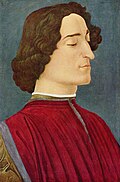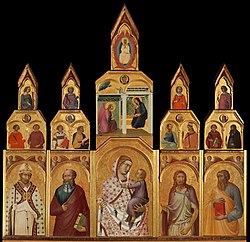Tempera

Tempera (sometimes known as egg tempera) is a type of artist's paint. It was the main medium used for panel painting and illuminated manuscripts in the Byzantine world and the Middle Ages in Europe, until it was replaced by oil painting as the most popular medium for large paintings. It is still used for Orthodox icons. Some modern painters use tempera.
In modern times, some manufacturers call ordinary poster paint by the name of "tempera". Poster paint is not really tempera. It is a different type of paint called gouache.
Painting with tempera
Egg yolk (the yellow part of the egg) dries and sticks very firmly. It is used to mix and set the paints in a tempera painting. The colours are ground up into dry powders that must be mixed by the artist. In earlier times, some of the paints were very poisonous and the artist had to be careful not to breathe in the powdered paint. The paints are generally mixed with equal parts of egg yolk and water. If there is too much egg, the paint is gooey. If there is too much water, it is runny. Neither of these things are good. Some artists like to mix some of the egg white as well, for a different effect. Sometimes some oil is added. In ancient times other things were added which might include honey, milk and plant gums.
The painting must be done over a "ground" that has already been prepared. The "ground" is smooth flat paint on a strong board that does not bend. The paint must be put on in thin layers with tiny brush strokes that dry very quickly. Because the paint is transparent the artists use a special technique. They often paint the shadows on the figure before they paint the skin colour and colour of the clothing over the top.
When the painting is finished, it is not very brightly coloured, until it has been varnished. This makes the colours bright and shiny. The good thing about tempera painting is that the colours do not change over the years, whereas oil paintings change, get darker and go more yellow. Tempera paintings can last well for at least two thousand years. Because tempera paintings take a long time to do, many of them are small. Sometimes artists painted large altarpieces in tempera. One of the biggest tempera paintings is Duccio's picture of the Madonna and Child in the Uffizi Gallery. It is about 15 feet high. Another very famous large tempera painting is Botticelli's Birth of Venus which is also in the Uffizi. (see picture above)
History
Some of the oldest paintings in tempera are funeral portraits of dead people done is Egypt during the time of Ancient Rome. Tempera continued to be used for Christian religious paintings. It was the medium for Greek icons and was used in Italy and many other countries until oil painting came into use, in about 1500. Most of the famous Italian Renaissance painters used tempera. This includes Duccio, Giotto, Fra Angelico, Botticelli and Michelangelo. In Northern Europe they used oil paint. This started to become popular in Italy in the 1570s. Leonardo painted the Mona Lisa in oil paint. Nowadays, although oil paint and vinyl paint are much more common, some artists paint in tempera. One of the most famous tempera painters of the 20th century is Andrew Wyeth.
Gallery of small tempera paintings
Byzantine icon- Christ the Judge, 5th or 6th century
Illuminated manuscript- Jesus and the Gospel Writers, 9th century
Proto Renaissance- Madonna and Child by the Master of St. Martin of Palma, 1300s
Renaissance- Portrait of Giuliano Medici by Botticelli, 1478
Illuminated manuscript- A hymn book by Niccolo da Bologna, c. 1500
Miniature painting- portrait of a soldier, c. 1840
Tempera Media
Crevole Madonna by Duccio, tempera with gold ground on wood, 1284, Siena
A 1367 tempera on wood by Niccolò Semitecolo
Pietro Lorenzetti's Tarlati polyptych, Tempera and gold on panel, 1320
Spanish, Altar Frontal with Christ in Majesty and the Life of Saint Martin, 1250, The Walters Art Museum
Duccio, Madonna and Child with saints polyptych, tempera and gold on wood, 1311–1318
Bernardo Daddi, Christ Enthroned with Saints Sebastian, Leo, Alexander, Peregrine, Philip, Rufianiaus, Justa, Concordius and Decentius, 14th century
Sassetta, detail of Virgin and Child with Four Saints, tempera on wood, 1435
Lorenzo d'Alessandro, The Crucifixion; Saint Michael, c. 1480–1490, The Walters Art Museum















